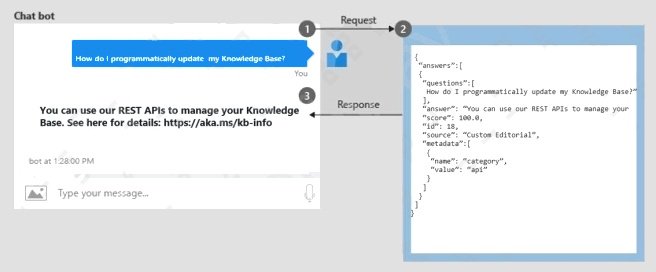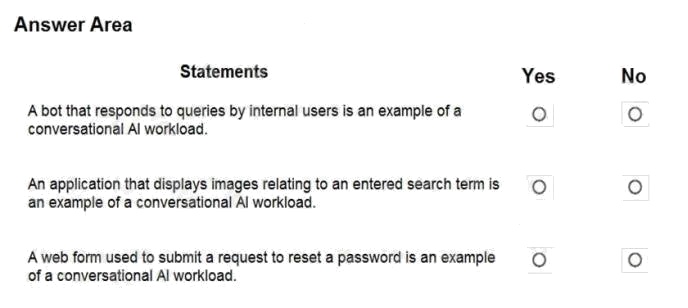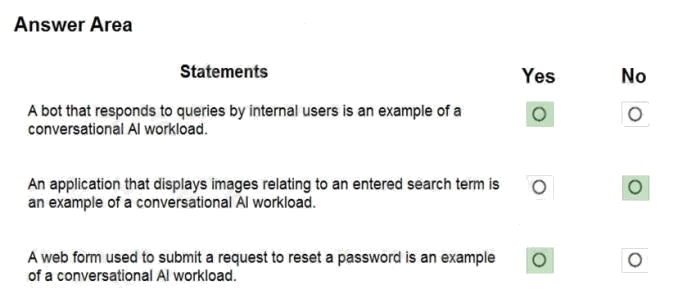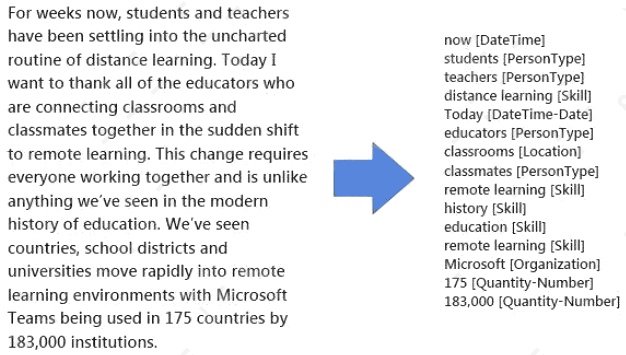microsoft ai-900 practice test
Microsoft Azure AI Fundamentals
Last exam update: Jul 20 ,2024
Question 1 Topic 5, Describe features of conversational AI workloads on Azure
You need to develop a web-based AI solution for a customer support system. Users must be able to interact with a web app
that will guide them to the best resource or answer.
Which service should you use?
- A. Custom Vision
- B. QnA Maker
- C. Translator Text
- D. Face
Answer:
B
Explanation:
QnA Maker is a cloud-based API service that lets you create a conversational question-and-answer layer over your existing
data. Use it to build a knowledge base by extracting questions and answers from your semi-structured content, including
FAQs, manuals, and documents. Answer users questions with the best answers from the QnAs in your knowledge base
automatically. Your knowledge base gets smarter, too, as it continually learns from user behavior.
Incorrect Answers:
A: Azure Custom Vision is a cognitive service that lets you build, deploy, and improve your own image classifiers. An image
classifier is an AI service that applies labels (which represent classes) to images, according to their visual characteristics.
Unlike the Computer Vision service, Custom Vision allows you to specify the labels to apply.
D: Azure Cognitive Services Face Detection API: At a minimum, each detected face corresponds to a faceRectangle field in
the response. This set of pixel coordinates for the left, top, width, and height mark the located face. Using these coordinates,
you can get the location of the face and its size. In the API response, faces are listed in size order from largest to smallest.
Reference:
https://azure.microsoft.com/en-us/services/cognitive-services/qna-maker/
Question 2 Topic 5, Describe features of conversational AI workloads on Azure
You have the process shown in the following exhibit.
Which type of AI solution is shown in the diagram?
- A. a sentiment analysis solution
- B. a chatbot
- C. a machine learning model
- D. a computer vision application
Answer:
B
Question 3 Topic 5, Describe features of conversational AI workloads on Azure
Which two scenarios are examples of a conversational AI workload? Each correct answer presents a complete solution.
NOTE: Each correct selection is worth one point.
- A. a smart device in the home that responds to questions such as “What will the weather be like today?”
- B. a website that uses a knowledge base to interactively respond to users’ questions
- C. assembly line machinery that autonomously inserts headlamps into cars
- D. monitoring the temperature of machinery to turn on a fan when the temperature reaches a specific threshold
Answer:
A B
Question 4 Topic 5, Describe features of conversational AI workloads on Azure
You need to reduce the load on telephone operators by implementing a chatbot to answer simple questions with predefined
answers.
Which two AI service should you use to achieve the goal? Each correct answer presents part of the solution.
NOTE: Each correct selection is worth one point.
- A. Text Analytics
- B. QnA Maker
- C. Azure Bot Service
- D. Translator
Answer:
B C
Explanation:
Bots are a popular way to provide support through multiple communication channels. You can use the QnA Maker service
and Azure Bot Service to create a bot that answers user questions.
Reference:
https://docs.microsoft.com/en-us/learn/modules/build-faq-chatbot-qna-maker-azure-bot-service/
Question 5 Topic 5, Describe features of conversational AI workloads on Azure
You have a frequently asked questions (FAQ) PDF file.
You need to create a conversational support system based on the FAQ.
Which service should you use?
- A. QnA Maker
- B. Text Analytics
- C. Computer Vision
- D. Language Understanding (LUIS)
Answer:
A
Explanation:
QnA Maker is a cloud-based API service that lets you create a conversational question-and-answer layer over your existing
data. Use it to build a knowledge base by extracting questions and answers from your semi-structured content, including
FAQs, manuals, and documents.
Reference:
https://azure.microsoft.com/en-us/services/cognitive-services/qna-maker/
Question 6 Topic 5, Describe features of conversational AI workloads on Azure
You need to provide content for a business chatbot that will help answer simple user queries.
What are three ways to create question and answer text by using QnA Maker? Each correct answer presents a complete
solution.
NOTE: Each correct selection is worth one point.
- A. Generate the questions and answers from an existing webpage.
- B. Use automated machine learning to train a model based on a file that contains the questions.
- C. Manually enter the questions and answers.
- D. Connect the bot to the Cortana channel and ask questions by using Cortana.
- E. Import chit-chat content from a predefined data source.
Answer:
A C E
Explanation:
Automatic extraction
Extract question-answer pairs from semi-structured content, including FAQ pages, support websites, excel files, SharePoint
documents, product manuals and policies.
Reference:
https://docs.microsoft.com/en-us/azure/cognitive-services/qnamaker/concepts/content-types
Question 7 Topic 5, Describe features of conversational AI workloads on Azure
HOTSPOT
For each of the following statements, select Yes if the statement is true. Otherwise, select No.
NOTE: Each correct selection is worth one point.
Hot Area:
Answer:

Explanation:
Reference:
https://docs.microsoft.com/en-us/azure/bot-service/bot-service-overview-introduction?view=azurebot-service-4.0
Question 8 Topic 5, Describe features of conversational AI workloads on Azure
You are developing a conversational AI solution that will communicate with users through multiple channels including email,
Microsoft Teams, and webchat.
Which service should you use?
- A. Text Analytics
- B. Azure Bot Service
- C. Translator
- D. Form Recognizer
Answer:
B
Explanation:
Reference:
https://docs.microsoft.com/en-us/azure/bot-service/bot-service-overview-introduction?view=azure-bot-service-4.0
Question 9 Topic 5, Describe features of conversational AI workloads on Azure
You have a webchat bot that provides responses from a QnA Maker knowledge base.
You need to ensure that the bot uses user feedback to improve the relevance of the responses over time.
What should you use?
- A. key phrase extraction
- B. sentiment analysis
- C. business logic
- D. active learning
Answer:
D
Explanation:
Reference: https://docs.microsoft.com/en-us/azure/cognitive-services/qnamaker/how-to/improve-knowledge-base
Question 10 Topic 4, Describe features of Natural Language Processing (NLP) workloads on Azure
You are building a Language Understanding model for an e-commerce business.
You need to ensure that the model detects when utterances are outside the intended scope of the model.
What should you do?
- A. Test the model by using new utterances
- B. Add utterances to the None intent
- C. Create a prebuilt task entity
- D. Create a new model
Answer:
B
Explanation:
The None intent is filled with utterances that are outside of your domain.
Reference:
https://docs.microsoft.com/en-us/azure/cognitive-services/LUIS/luis-concept-intent
Topic 5, Describe features of conversational AI workloads on Azure
Question 11 Topic 4, Describe features of Natural Language Processing (NLP) workloads on Azure
You need to develop a chatbot for a website. The chatbot must answer users questions based on the information in the
following documents:
A product troubleshooting guide in a Microsoft Word document
A frequently asked questions (FAQ) list on a webpage
Which service should you use to process the documents?
- A. Azure Bot Service
- B. Language Understanding
- C. Text Analytics
- D. QnA Maker
Answer:
D
Explanation:
Reference: https://docs.microsoft.com/en-us/azure/cognitive-services/QnAMaker/Overview/overview
Question 12 Topic 4, Describe features of Natural Language Processing (NLP) workloads on Azure
You build a QnA Maker bot by using a frequently asked questions (FAQ) page.
You need to add professional greetings and other responses to make the bot more user friendly.
What should you do?
- A. Increase the confidence threshold of responses
- B. Enable active learning
- C. Create multi-turn questions
- D. Add chit-chat
Answer:
D
Explanation:
Reference: https://docs.microsoft.com/en-us/azure/cognitive-services/qnamaker/how-to/chit-chat-knowledge-base?tabs=v1
Question 13 Topic 4, Describe features of Natural Language Processing (NLP) workloads on Azure
You are authoring a Language Understanding (LUIS) application to support a music festival.
You want users to be able to ask questions about scheduled shows, such as: Which act is playing on the main stage? The
question Which act is playing on the main stage? is an example of which type of element?
- A. an intent
- B. an utterance
- C. a domain
- D. an entity
Answer:
B
Explanation:
Utterances are input from the user that your app needs to interpret.
Reference:
https://docs.microsoft.com/en-us/azure/cognitive-services/LUIS/luis-concept-utterance
Question 14 Topic 4, Describe features of Natural Language Processing (NLP) workloads on Azure
DRAG DROP
You plan to apply Text Analytics API features to a technical support ticketing system.
Match the Text Analytics API features to the appropriate natural language processing scenarios.
To answer, drag the appropriate feature from the column on the left to its scenario on the right. Each feature may be used
once, more than once, or not at all.
NOTE: Each correct selection is worth one point.
Select and Place:
Answer:

Explanation:
Box1: Sentiment analysis
Sentiment Analysis is the process of determining whether a piece of writing is positive, negative or neutral.
Box 2: Broad entity extraction
Broad entity extraction: Identify important concepts in text, including key
Key phrase extraction/ Broad entity extraction: Identify important concepts in text, including key phrases and named entities
such as people, places, and organizations.
Box 3: Entity Recognition
Named Entity Recognition: Identify and categorize entities in your text as people, places, organizations, date/time, quantities,
percentages, currencies, and more. Well-known entities are also recognized and linked to more information on the web.
Reference:
https://docs.microsoft.com/en-us/azure/architecture/data-guide/technology-choices/natural-language-processing
https://azure.microsoft.com/en-us/services/cognitive-services/text-analytics
Question 15 Topic 4, Describe features of Natural Language Processing (NLP) workloads on Azure
You use natural language processing to process text from a Microsoft news story.
You receive the output shown in the following exhibit.
Which type of natural languages processing was performed?
- A. entity recognition
- B. key phrase extraction
- C. sentiment analysis
- D. translation
Answer:
A
Explanation:
Named Entity Recognition (NER) is the ability to identify different entities in text and categorize them into pre-defined classes
or types such as: person, location, event, product, and organization.
In this question, the square brackets indicate the entities such as DateTime, PersonType, Skill.
Reference:
https://docs.microsoft.com/en-in/azure/cognitive-services/text-analytics/how-tos/text-analytics-how-to-entity-
linking?tabs=version-3-preview